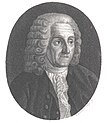
Back Escala Delisle AST Escala Delisle Catalan Delisleskala German Escala Delisle Spanish Delisle gradu Basque مقیاس دلیزل Persian Delisle-asteikko Finnish Delislestigin Faeroese Échelle Delisle French Delisle-Skala FRR
| from Delisle | to Delisle | |
|---|---|---|
| Celsius | x °De ≘ (100 − x × 2/3) °C | x °C ≘ (100 − x) × 3/2 °De |
| Fahrenheit | x °De ≘ (212 − x × 6/5) °F | x °F ≘ (212 − x) × 5/6 °De |
| Kelvin | x °De ≘ (373.15 − x × 2/3) K | x K ≘ (373.15 − x) × 3/2 °De |
| Rankine | x °De ≘ (671.67 − x × 6/5) °R | x °R ≘ (671.67 − x) × 5/6 °De |
| For temperature intervals rather than specific temperatures, 1 °De = 2/3 °C = 1.2 °F Conversion between temperature scales | ||

The Delisle scale is a temperature scale invented in 1732 by the French astronomer Joseph-Nicolas Delisle (1688–1768).[1] The Delisle scale is notable as one of the few temperature scales that are inverted from the amount of thermal energy they measure; unlike most other temperature scales, higher measurements in degrees Delisle are colder, while lower measurements are warmer.[a]
- ^ Camuffo, Dario (2002). Improved Understanding of Past Climatic Variability from Early Daily European Instrumental Sources. Kluwer Academic Publishers. p. 314.
Cite error: There are <ref group=lower-alpha> tags or {{efn}} templates on this page, but the references will not show without a {{reflist|group=lower-alpha}} template or {{notelist}} template (see the help page).